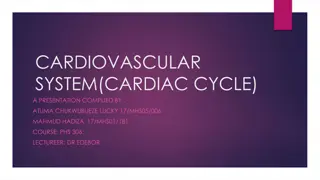Step On Up: Peripheral Arterial Disease (PAD)
Peripheral Arterial Disease (PAD), a condition caused by reduced blood flow in the legs or arms. Understand the symptoms, signs, importance of early detection, and who is at risk. Find out about the tests for PAD.
0 views • 18 slides
Echocardiographic Assessment of Pulmonary Arterial Hypertension (PAH) Overview
Echocardiographic assessment plays a crucial role in the diagnosis, management, and prognostic evaluation of pulmonary arterial hypertension (PAH). This condition is characterized by elevated mean pulmonary arterial pressure and pulmonary vascular resistance, leading to various clinical features suc
6 views • 43 slides
Understanding Coronary Artery Bypass Graft (CABG) in Adult Nursing
Coronary Artery Bypass Graft (CABG) is a surgical procedure where a blood vessel from another part of the body is grafted onto an occluded coronary artery to bypass blockages. This procedure is less common in women compared to men and is typically indicated for severe coronary artery disease. It is
5 views • 15 slides
2022 Thales Access Management Index
Thales Access Management Index highlights the current landscape of access security, revealing insights on multi-factor authentication adoption, remote and privileged user access management, VPN usage trends, challenges faced, and preferences towards third-party access management. The report emphasiz
2 views • 9 slides
Early Vasopressors in Sepsis Clinical Trial: Improving Patient Outcomes
This UK-wide clinical trial aims to assess the effectiveness of early peripheral norepinephrine infusion in adult patients with septic shock. The study will compare the impact on mortality and other outcomes of targeting a mean arterial pressure (MAP) above 65mmHg within the first 48 hours of admiss
1 views • 9 slides
Personnel Safety Systems and Access Control at CERN Facilities
Personnel Safety Systems at CERN include ODH detection, fire safety measures, and access control to protect personnel from hazards. Various access control layers are implemented to regulate entry to different parts of the facility, ensuring only trained personnel access underground areas. Biometric
0 views • 19 slides
Urban Planning and Road Design Guidelines
Explore various road patterns like rectangular, radial, and hexagonal, along with classifications from arterial to local streets. Understand design considerations such as speed limits, access, and spacing for different road types. Learn about factors influencing road alignment and requirements for h
0 views • 21 slides
Detailed Anatomy Review for GIT Blood Supply
This content provides a thorough anatomy revision focusing on the blood supply of the gastrointestinal tract (GIT). It covers stations discussing the blood supply of the stomach, complications during cholecystectomy, perforated duodenal ulcer scenarios, pancreatic tumors, and structures related to m
0 views • 15 slides
Understanding the Blood Supply of the Brain
The brain receives its blood supply from four major arteries - two vertebral arteries and two internal carotid arteries. The vertebral arteries branch into the basilar artery, which gives rise to various important branches. The internal carotid arteries supply the anterior and middle cerebral arteri
1 views • 30 slides
Understanding Pulmonary Circulation and Its Importance in Respiratory Physiology
Pulmonary circulation, as explained by Professor Narsingh Verma, plays a crucial role in the respiratory system, showcasing distinct differences from systemic circulation. The low pressure and resistance in pulmonary circulation allow for optimal gas exchange at the alveolocapillary membrane. Variou
1 views • 30 slides
Kent and Medway Vascular Programme: 2021 Refresh of Options Appraisal
The Kent and Medway Vascular Programme underwent a review in 2014 that identified the need for a different setup of vascular services due to existing providers not meeting national standards. Subsequent options appraisals in 2016 and beyond led to the recommendation of a single dedicated specialist
0 views • 21 slides
Understanding Hypertension: Types, Pathogenesis, and Management
The article discusses the physiological basis, types, pathogenesis, and genetic predisposition of hypertension. It explains the revision of terminology related to blood pressure and the calculation of mean arterial pressure. Secondary hypertension, causes, and mean arterial pressure determination ar
0 views • 29 slides
Understanding Acid-Base Balance in Health and Disease
Many critical illnesses can disrupt acid-base balance, indicating underlying diseases or organ damage. Interpretation of disturbances requires analyzing arterial blood gases, plasma electrolytes, and compensatory mechanisms. Acid-base disorders are classified into respiratory acidosis, respiratory a
3 views • 26 slides
Understanding Renal Physiology: The Role of the Kidneys in Maintaining Homeostasis
The urinary system consists of the kidneys, ureters, urinary bladder, and urethra, playing a crucial role in regulating blood volume, ion concentration, and pH. The kidneys, as the major excretory organ, remove metabolic waste products and help maintain water-electrolyte balance, regulate arterial p
0 views • 27 slides
Best Practices for Transradial Angiography & Intervention Update
Expert consensus statements provide guidance on utilizing ultrasound guidance for arterial access, preferring radial over ulnar artery access, and the utility of non-invasive collateral flow assessment. Recommendations include administering heparin post-sheath placement and using low-profile sheaths
0 views • 7 slides
Understanding Blood Pressure Physiology in a Lab Setting
Blood pressure (BP) is the lateral pressure exerted by the column of blood on the artery wall. This lab aims to determine BP at rest and after exercise using a sphygmomanometer and stethoscope. Learn about systolic and diastolic pressures, pulse pressure, and mean arterial pressure. Methods include
1 views • 17 slides
Understanding Coronary Circulation and Arterial Supply in Cardiovascular Physiology
Explore the intricate details of coronary circulation, including arterial supply, branches of coronary arteries, and areas of distribution. Dr. Abeer Al-Masri, an Associate Professor and Cardiovascular Physiologist at the Faculty of Medicine, KSU, provides valuable insights on the topic, covering th
1 views • 30 slides
Understanding the Intrinsic Muscles of the Tongue - Anatomy and Physiology Overview
In this detailed presentation by Dr. Sushma Tomar, Associate Professor of Anatomy, the intrinsic muscles of the tongue are explored, along with their functions, arterial and venous supply, lymphatic drainage, and nerve supply. The lecture covers the four intrinsic muscles in each half of the tongue,
1 views • 15 slides
Understanding the Cardiac Cycle: A Comprehensive Overview
The cardiac cycle, involving systole and diastole processes, consists of arterial and ventricular events essential for heart function. Arterial events include systole and diastole, while ventricular events encompass isometric contraction, ejection period, prodiastole, isometric relaxation, rapid fil
2 views • 8 slides
Understanding the Anatomy of Ureters, Urinary Bladder, and Urethra
Explore the detailed anatomy of ureters, urinary bladder, and urethra in this comprehensive guide. Learn about the course of ureters, important relations of the urinary bladder, and differences in male and female urethra. Discover the sites of ureteric constrictions, arterial blood supply, and more.
0 views • 22 slides
Overview of Pituitary Gland: Structure, Function, and Relationships
The pituitary gland, also known as the hypophysis, is an endocrine gland located at the base of the brain. It is divided into two main parts: the adenohypophysis and the neurohypophysis. The gland plays a crucial role in hormone regulation and is closely related to neighboring structures such as the
0 views • 26 slides
Understanding Heartworm Infection in Dogs
Heartworm infection in dogs is caused by infective larvae that mature into adult worms, leading to potential complications such as pulmonary arterial wall thickening and increased right heart pressure. Clinical signs may include tiredness, shortness of breath, and weight loss. Diagnosis involves ant
0 views • 9 slides
Understanding Cyanosis: Causes, Types, and Clinical Differentiation
Cyanosis is characterized by a bluish discoloration of the skin and mucous membranes due to increased levels of reduced hemoglobin. This condition can be categorized as central or peripheral cyanosis, each with distinct characteristics and causes. Central cyanosis results from decreased oxygen satur
0 views • 13 slides
Managing Speeding Opportunities on Arterial Streets Using Traffic Signals
The study discusses strategies to limit speeding opportunities on arterial streets, particularly focusing on the impact of traffic signal coordination on reducing speeding incidents. Results from simulation tests and real-world observations are presented, highlighting the effectiveness of signal con
0 views • 16 slides
Comprehensive Guide to Acid-Base Disorders Interpretation
This comprehensive guide provides a systematic approach to interpreting arterial blood gas (ABG) samples, including multiple formulas and rules to navigate complex diagnoses. It outlines five essential steps in acid-base analysis and emphasizes the importance of routine application for improving pat
0 views • 50 slides
Morphologic and Physiologic Connections in Blood Pressure Waveforms for Cardiovascular Event Prediction
This report discusses the morphologic and physiologic connections in continuous blood pressure waveforms and their association with incident cardiovascular events. The study aims to assess if changes in arterial elasticity contribute to predicting CVD events and explores additional measures derived
0 views • 30 slides
Pediatric Vascular Access Techniques and Considerations
This article discusses various vascular access methods in infants and children, including peripheral IV access, central venous access, arterial lines, and ultrasound-guided techniques. It covers indications, sites, complications, and techniques for each method, emphasizing the importance of proper a
1 views • 56 slides
Portal Vein Imaging Techniques and Anomalies Overview
Portal vein imaging is crucial for evaluating conditions affecting the abdominal part of the gastrointestinal tract. Techniques such as spleno-portography and CT triphasic contrast imaging are used to visualize the portal vein and diagnose anomalies like portal-systemic collaterals and porto-systemi
4 views • 7 slides
Understanding Peripheral Arterial Disease (PAD) - Overview and Management
Peripheral Arterial Disease (PAD) refers to the narrowing of blood vessels outside the heart and brain, leading to reduced blood flow. This condition can result from atherosclerosis, inflammation, embolism, or thrombus formation. Learn about the causes, symptoms, diagnosis, and treatment strategies
5 views • 34 slides
Comprehensive Medical Management of Peripheral Arterial Disease (PAD)
Discussing the challenges and gaps in the medical management of PAD, this presentation by Dr. Faisal Latif highlights the unique issues faced by patients with PAD and the limitations of current treatment options. It delves into the current guidelines for symptomatic PAD and explores the findings of
0 views • 24 slides
Overview of the Cardiovascular System and Arterial Blood Vessels
The cardiovascular system includes the heart, arteries, veins, and capillaries, responsible for the transport of blood and lymph throughout the body. Arterial blood vessels are classified based on diameter into large (elastic) arteries, medium (muscular) arteries, and arterioles. The arterial wall c
0 views • 13 slides
Understanding Arterial Blood Gases and Oxygen Delivery Devices
Arterial blood gases (ABG) are obtained from arteries to assess acid-base balance and blood oxygen levels. The pH, PaCO2, PaO2, HCO3, and SaO2 are crucial values on an ABG report. These values reflect the blood's acid-base status, carbon dioxide levels, oxygen saturation, and more. The buffer system
0 views • 25 slides
Open Access at Charles University: Opportunities and Challenges
Charles University is navigating the landscape of open access following the implementation of the Czech National Open Access Strategy. The university is working towards making all research articles and proceeding papers open access, monitoring article processing charges, and promoting open access as
0 views • 24 slides
Understanding Ethernet and Multiple Access Protocols in Computer Networks
Exploring the fundamentals of Ethernet and multiple access protocols in computer networks, this content discusses the two primary categories of multiple access protocols - contention access and controlled access. It delves into topics such as CSMA/CD, LANs, performance of multiple access schemes, ad
0 views • 7 slides
Understanding Pulmonary Arterial Hypertension (PAH): Causes, Symptoms, and Management
Pulmonary Arterial Hypertension (PAH) is a progressive disease characterized by increased blood pressure in the pulmonary artery, veins, or capillaries. This condition can lead to right ventricular failure and eventual death if left untreated. PAH can have various causes, including idiopathic factor
0 views • 49 slides
Comprehensive Guide to Blood Collection Techniques in Medical Investigations
Blood collection is a crucial process in medical investigations where blood is withdrawn from patients for analysis. Methods include arterial sampling, venipuncture, and fingerstick sampling, each serving specific purposes. Venous blood is preferred over arterial blood due to accessibility and ease
0 views • 10 slides
Automated Road Condition Survey Using Laser Imaging and Ranging Detection - June 2022
Infrastructure Committee conducted an Automated Road Condition Survey using Laser Imaging and Ranging Detection in June 2022. The survey covered 5835 km of roads with a value of $7B. It included sub-arterial, arterial roads, and industrial access, with key indicators for performance criteria. The su
0 views • 9 slides
Importance of Access Management near Interchanges
Access management near interchanges is crucial for ensuring efficient traffic flow, minimizing conflicts, and enhancing the overall performance of crossroads and highways. By strategically controlling access points, separating turning movements, and optimizing spacing, the goal is to improve safety,
0 views • 11 slides
Understanding Atherosclerosis and Peripheral Artery Diseases
Atherosclerosis is a progressive process triggered by an inflammatory response, often aggravated by hypertension. Conditions like claudication and critical limb ischemia are indications of inadequate blood flow, posing risks of rest pain and ischemic ulcers. Recognizing symptoms like pain, numbness,
0 views • 4 slides
Understanding Cardiopulmonary Bypass and Arterial Blood Flow in Perfusion Services
Explore the principles of cardiopulmonary bypass (CPB) and the intricacies of arterial blood flow regulation in perfusionist services. Delve into the control and management of physiological parameters during CPB to ensure optimal patient outcomes.
0 views • 20 slides







































